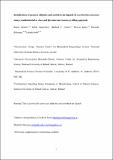| dc.contributor.author | Houeix, Benoit | |
| dc.contributor.author | Synowsky, Silvia | |
| dc.contributor.author | Cairns, Michael T. | |
| dc.contributor.author | Kane, Marian | |
| dc.contributor.author | Kilcoyne, Michelle | |
| dc.contributor.author | Joshi, Lokesh | |
| dc.date.accessioned | 2020-01-03T09:51:21Z | |
| dc.date.issued | 2019-11-11 | |
| dc.identifier.citation | Houeix, Benoit, Synowsky, Silvia, Cairns, Michael T, Kane, Marian, Kilcoyne, Michelle, & Joshi, Lokesh. (2019). Identification of putative adhesins and carbohydrate ligands of Lactobacillus paracasei using a combinatorial in silico and glycomics microarray profiling approach. Integrative Biology, 11(7), 315-329. doi: 10.1093/intbio/zyz026 | en_IE |
| dc.identifier.issn | 1757-9708 | |
| dc.identifier.uri | http://hdl.handle.net/10379/15666 | |
| dc.description.abstract | Commensal bacteria must colonize host mucosal surfaces to exert health-promoting properties, and bind to gastrointestinal tract (GIT) mucins via their cell surface adhesins. Considerable effort has been directed towards discovery of pathogen adhesins and their ligands to develop anti-infective strategies; however, little is known about the lectin-like adhesins and associated carbohydrate ligands in commensals. In this study, an in silico approach was used to detect surface exposed adhesins in the human commensal Lactobacillus paracasei subsp. paracasei, a promising probiotic commonly used in dairy product fermentation that presents anti-microbial activity. Of the 13 adhesin candidates, 3 sortase-dependent pili clusters were identified in this strain and expression of the adhesin candidate genes was confirmed in vitro. Mass spectrometry analysis confirmed the presence of surface adhesin elongation factor Tu and the chaperonin GroEL, but not pili expression. Whole cells were subsequently incubated on microarrays featuring a panel of GIT mucins from nine different mammalian species and two human-derived cell lines and a library of carbohydrate structures. Binding profiles were compared to those of two known pili-producing lactobacilli, L. johnsonii and L. rhamnosus and all Lactobacillus species displayed overlapping but distinct signatures, which may indicate different abilities for regiospecific GIT colonization. In addition, L. paracasei whole cells favoured binding to ¿-(2 ¿ 3)-linked sialic acid and ¿-(1 ¿ 2)-linked fucose-containing carbohydrate structures including blood groups A, B and O and Lewis antigens x, y and b. This study furthers our understanding of host-commensal cross-talk by identifying potential adhesins and specific GIT mucin and carbohydrate ligands and provides insight into the selection of colonization sites by commensals in the GIT. | en_IE |
| dc.description.sponsorship | This work was supported by Science Foundation Ireland Strategic Research Cluster
programme in support of Alimentary Glycoscience Research Cluster (grant number
08/SRC/B1393). MK is grateful to the Royal Society of Chemistry Analytical Chemistry
Trust Fund (ACTF) for the ACTF Fellowship Award 2018. The authors acknowledge the
Centre for Microscopy & Imaging at the National University of Ireland, Galway (NUI,
Galway) funded by NUI Galway and the Irish Government Programme for Research in Third
Level Institutions, Cycles 4 and 5, National Development Plan 2007-2013. The authors thank
Prof. Maarten Van de Guchte and Mr Valentin Loux, Unité Mathématique, Informatique et
Génome, INRA, Jouy en Josas, France for help with SurfG+ analysis, Prof. Y. C. Lee,
Department of Biology, Johns Hopkins University, Baltimore, Maryland, U.S.A., for the kind
gift of pigeon egg white and Prof. Stephen D. Carrington, Dr. Mary E. Gallagher, Dr. Colm
Reid and Dr. Marguerite Clyne of University College Dublin for the kind gift of mucins. | en_IE |
| dc.format | application/pdf | en_IE |
| dc.language.iso | en | en_IE |
| dc.publisher | Oxford University Press (OUP) | en_IE |
| dc.relation.ispartof | Integrative Biology : Quantitative Biosciences From Nano To Macro | en |
| dc.rights | Attribution-NonCommercial-NoDerivs 3.0 Ireland | |
| dc.rights.uri | https://creativecommons.org/licenses/by-nc-nd/3.0/ie/ | |
| dc.subject | carbohydratesadhesins | en_IE |
| dc.subject | bacterialantigenscell | en_IE |
| dc.subject | linesch | en_IE |
| dc.subject | aperonin | en_IE |
| dc.subject | bacterial | en_IE |
| dc.subject | fimbrial | en_IE |
| dc.subject | actobacillus | en_IE |
| dc.subject | lectin | en_IE |
| dc.subject | ligands | en_IE |
| dc.subject | mammals | en_IE |
| dc.subject | mucins | en_IE |
| dc.subject | peptide | en_IE |
| dc.subject | elongation | en_IE |
| dc.subject | factor | en_IE |
| dc.subject | tumass | en_IE |
| dc.subject | spectrometry | en_IE |
| dc.subject | bacteria | en_IE |
| dc.subject | pathogenic | en_IE |
| dc.subject | organism | en_IE |
| dc.subject | gastrointestinal | en_IE |
| dc.subject | tractmicrobial | en_IE |
| dc.subject | colonization | en_IE |
| dc.subject | binding (molecular function) | en_IE |
| dc.subject | lactobacillus | en_IE |
| dc.subject | paracasei | en_IE |
| dc.title | Identification of putative adhesins and carbohydrate ligands of Lactobacillus paracasei using a combinatorial in silico and glycomics microarray profiling approach | en_IE |
| dc.type | Article | en_IE |
| dc.date.updated | 2020-01-03T08:54:16Z | |
| dc.identifier.doi | 10.1093/intbio/zyz026 | |
| dc.local.publishedsource | https://doi.org/10.1093/intbio/zyz026 | en_IE |
| dc.description.peer-reviewed | peer-reviewed | |
| dc.contributor.funder | Science Foundation Ireland | en_IE |
| dc.contributor.funder | Royal Society of Chemistry Analytical Chemistry Trust Fund | en_IE |
| dc.description.embargo | 2020-11-11 | |
| dc.internal.rssid | 19058701 | |
| dc.local.contact | Michelle Kilcoyne, Glycosciences, School Of Natural Sciences, Nui Galway. 5885 Email: michelle.kilcoyne@nuigalway.ie | |
| dc.local.copyrightchecked | Yes | |
| dc.local.version | ACCEPTED | |
| dcterms.project | info:eu-repo/grantAgreement/SFI/SFI Strategic Research Cluster/08/SRC/B1393/IE/SRC AGRC: Glycoscience Research Cluster/ | en_IE |
| nui.item.downloads | 245 | |


